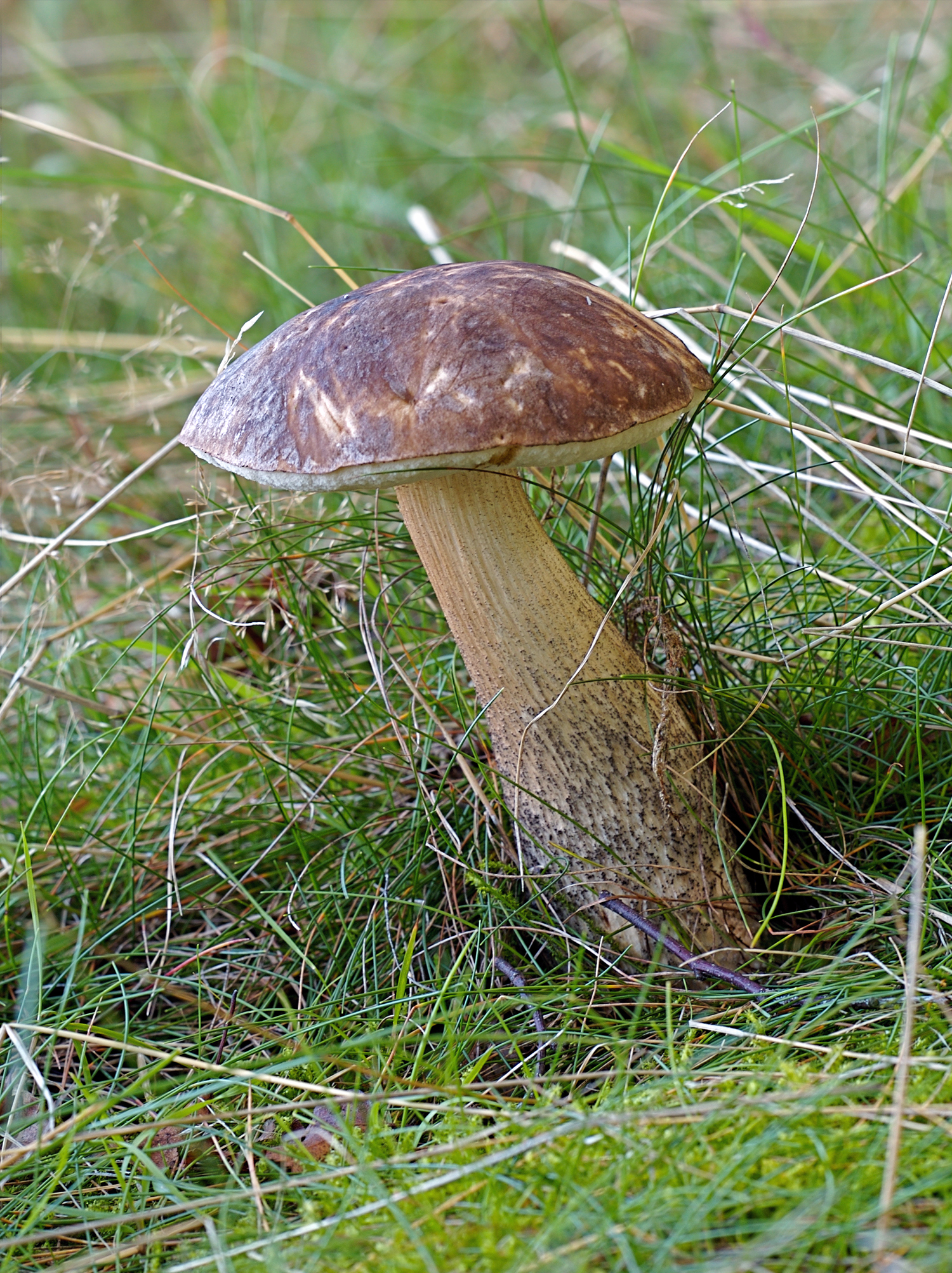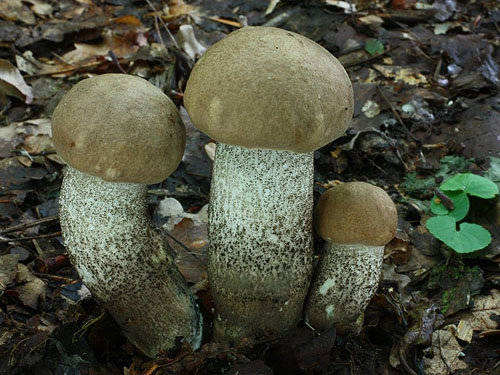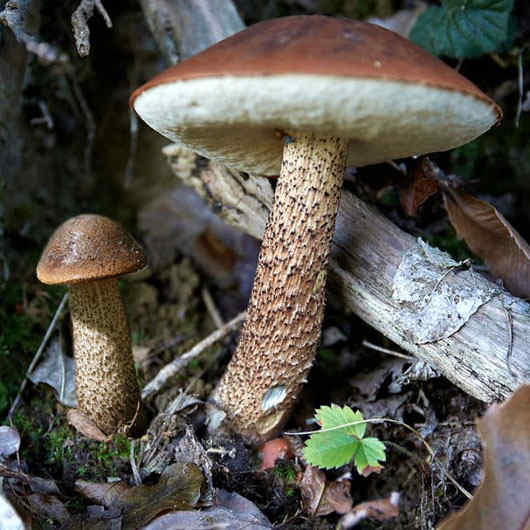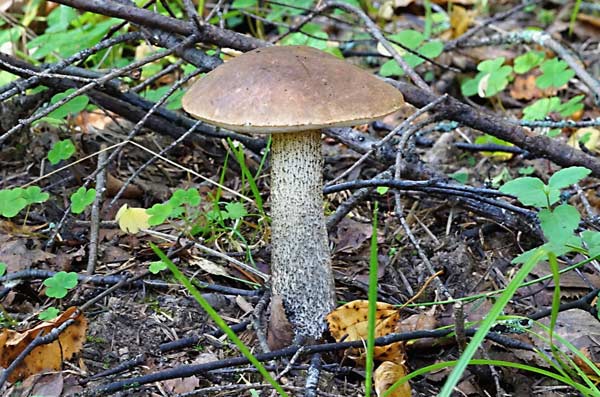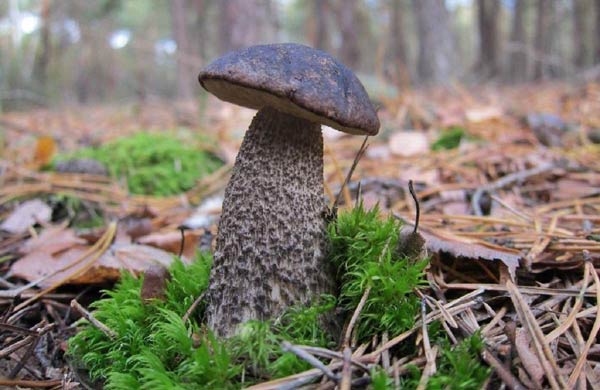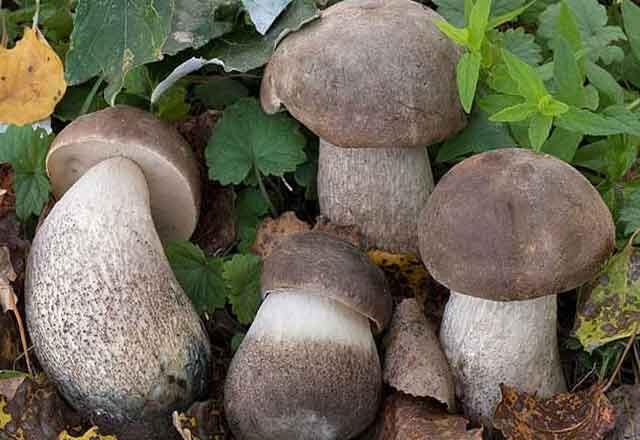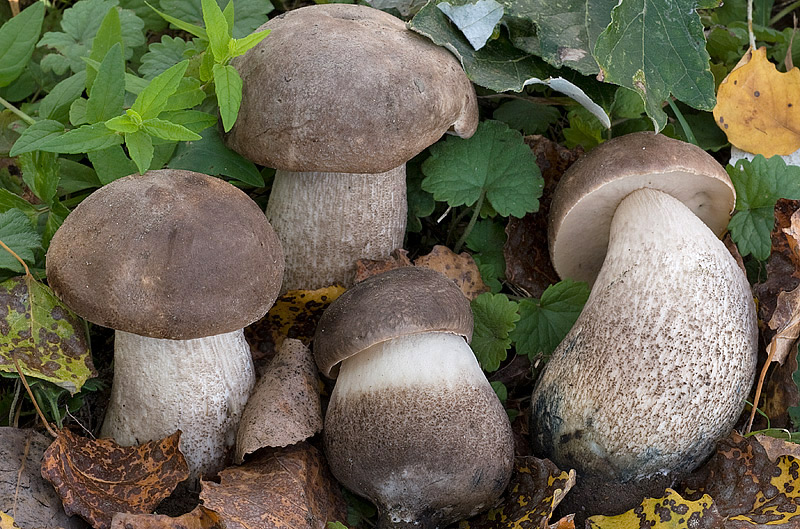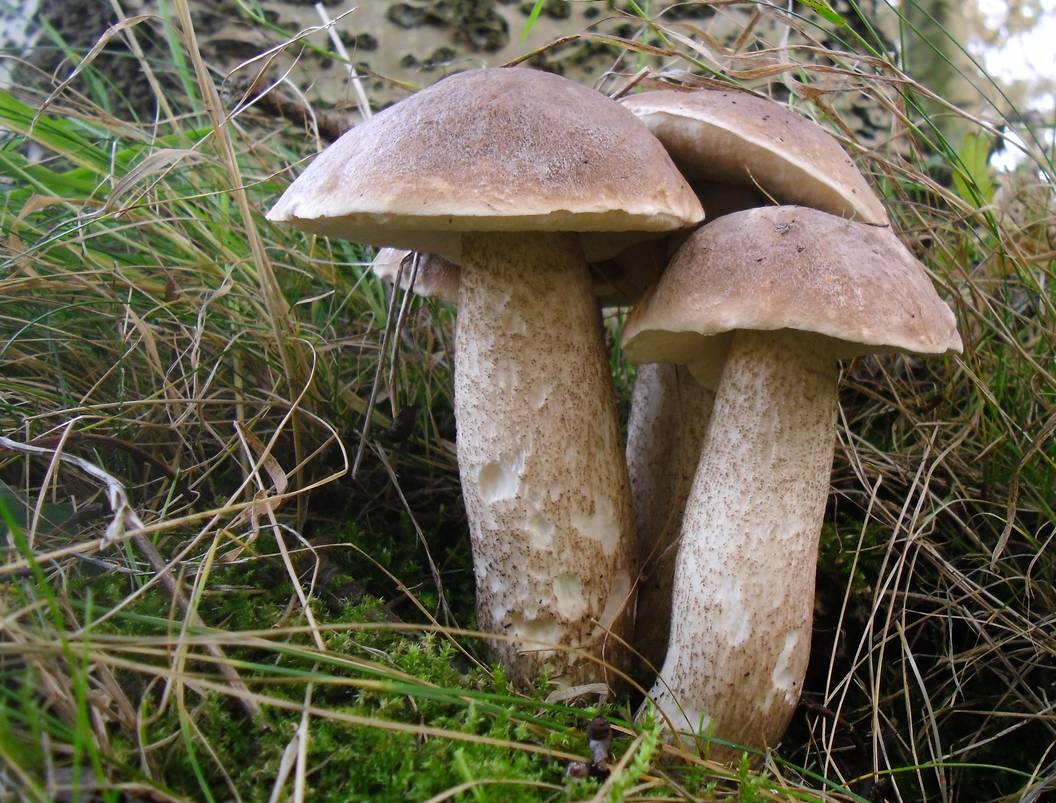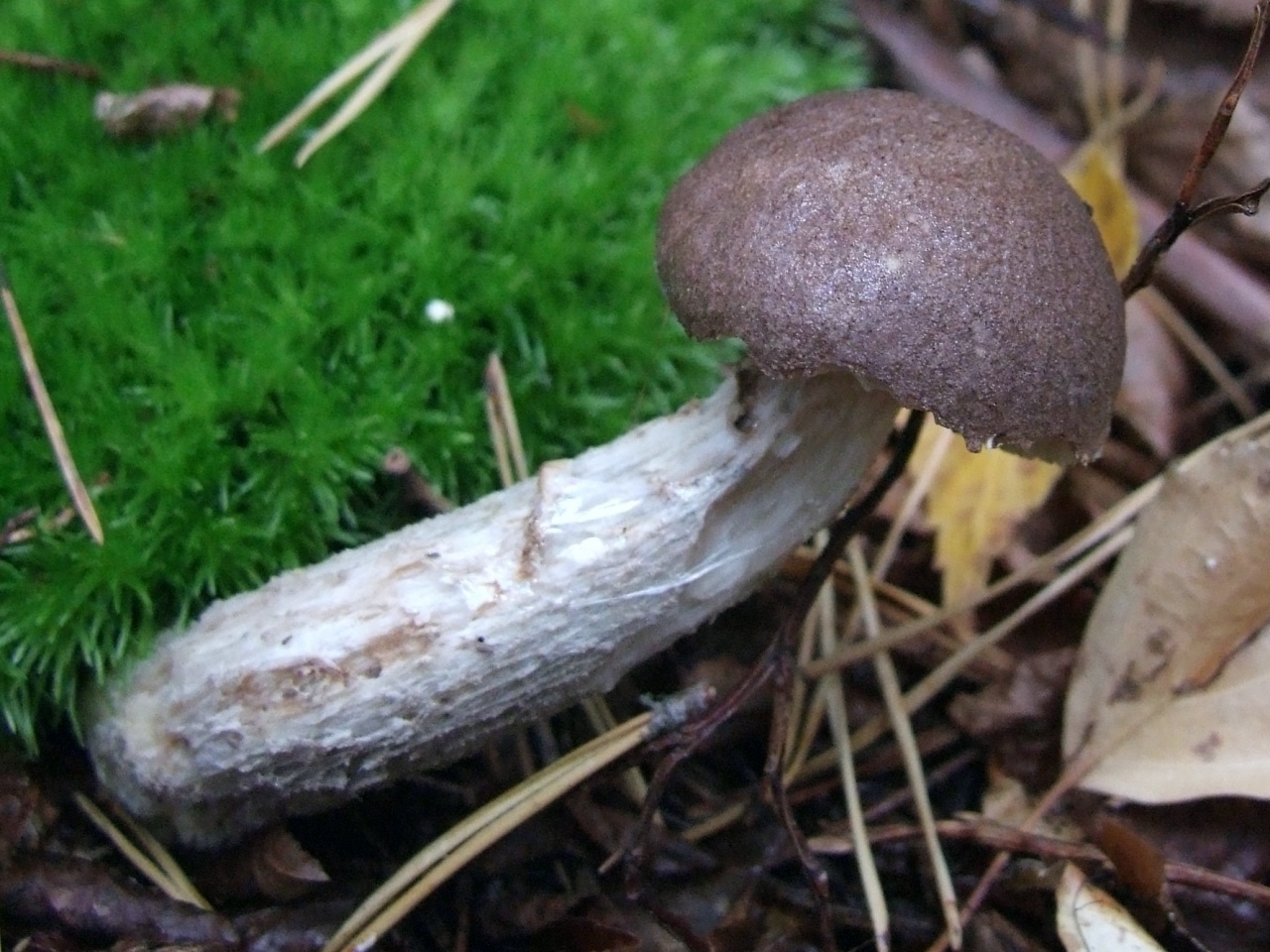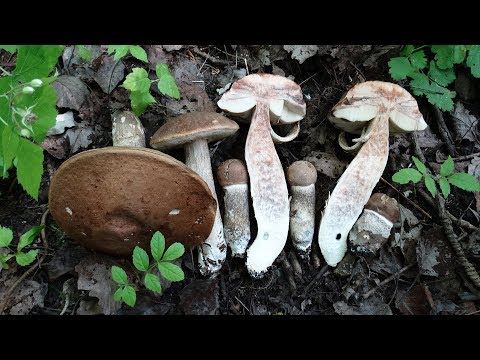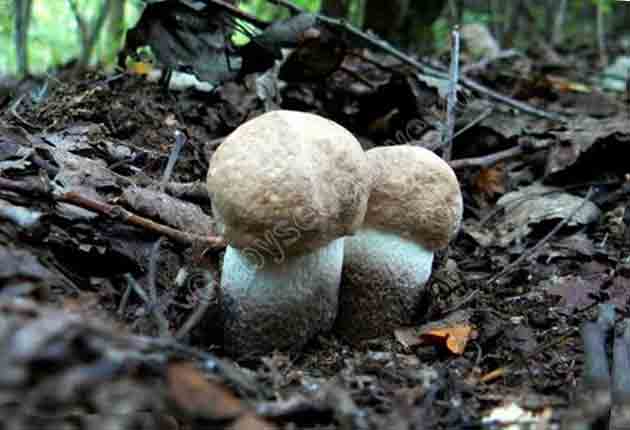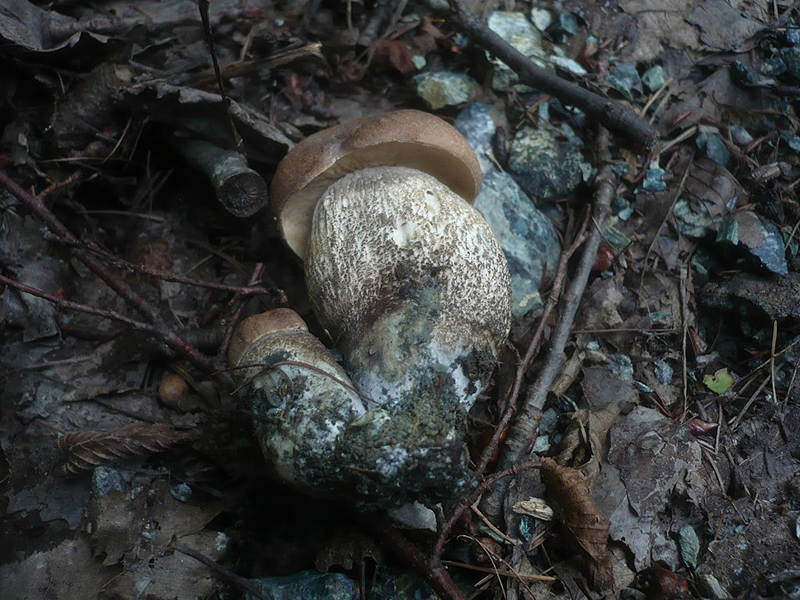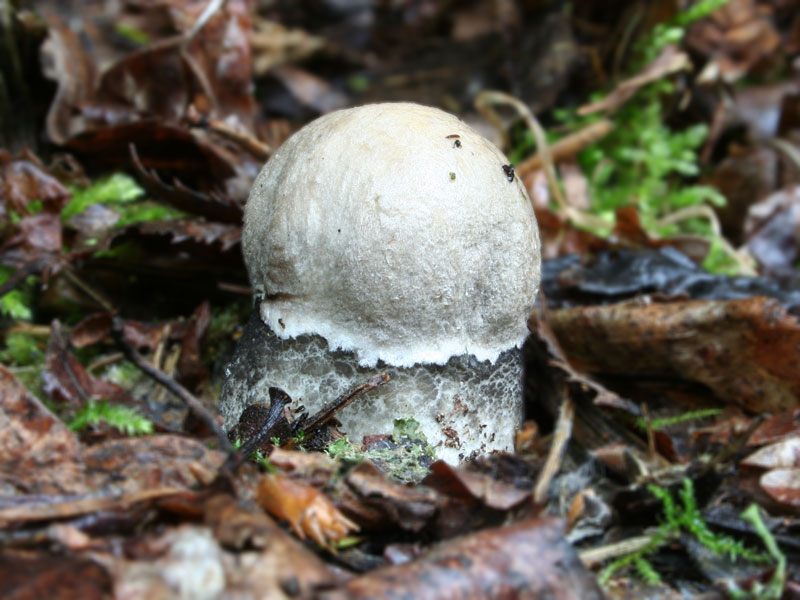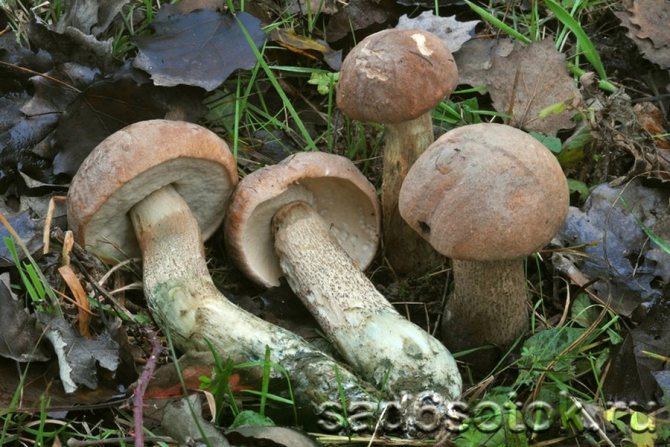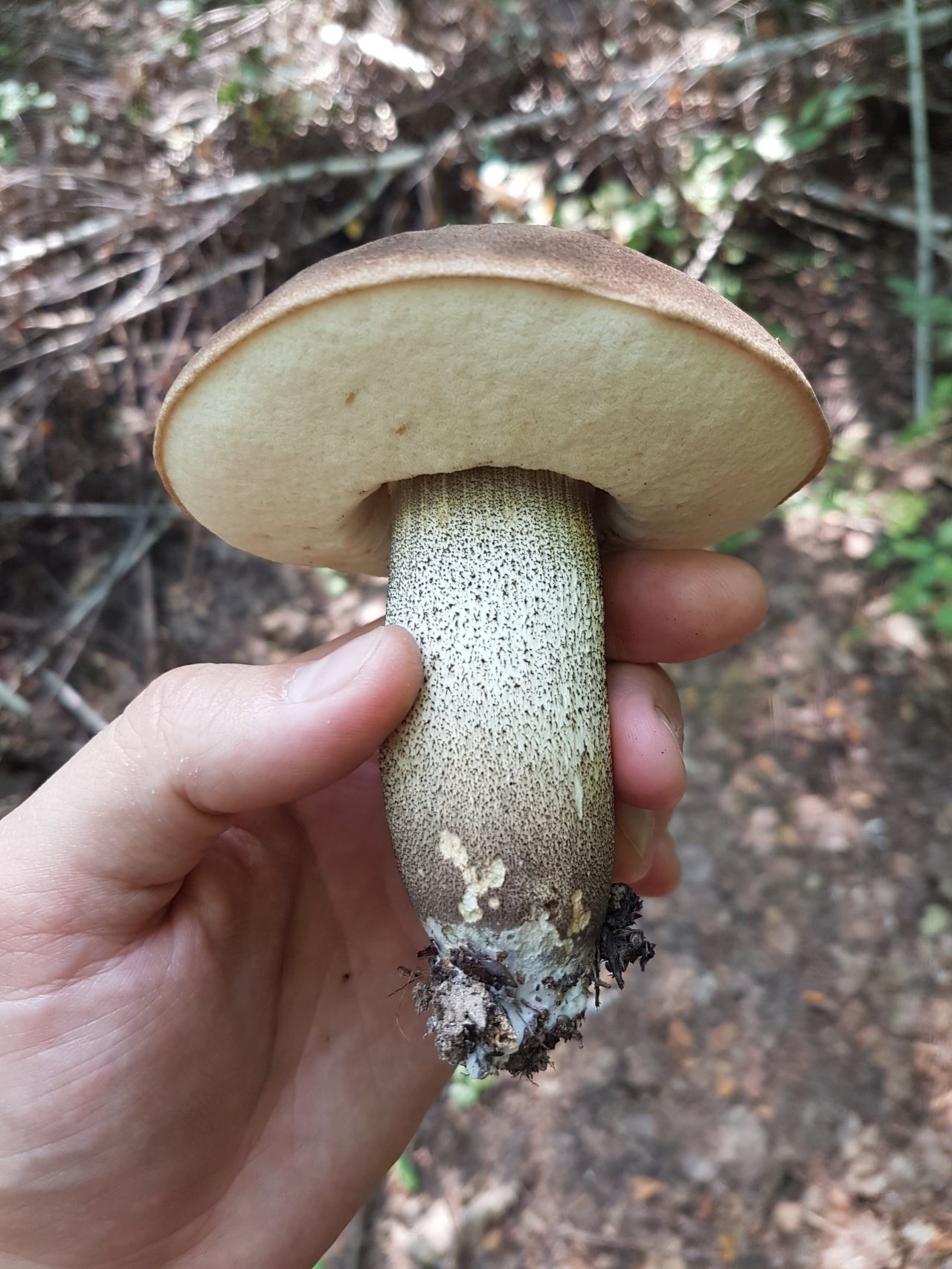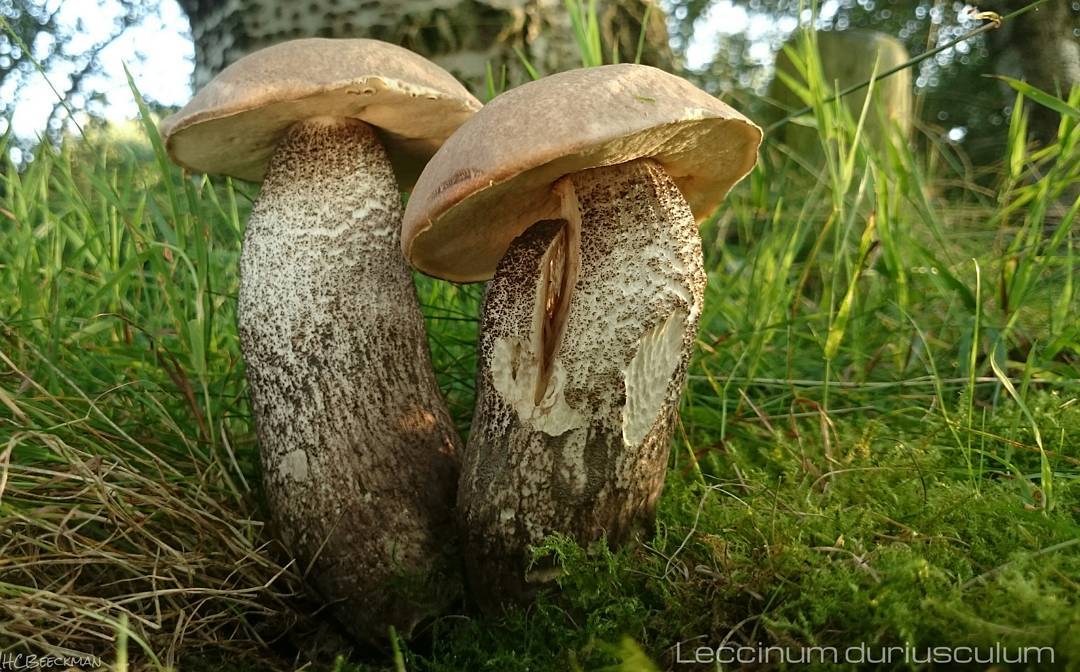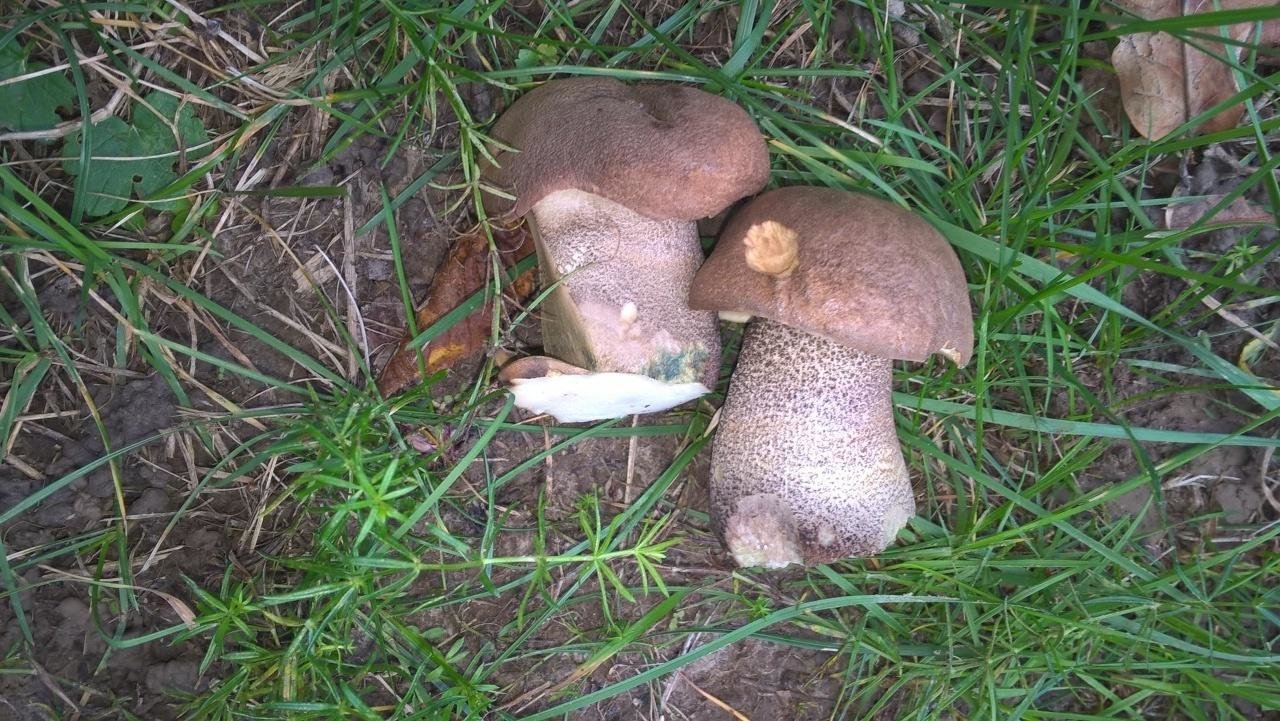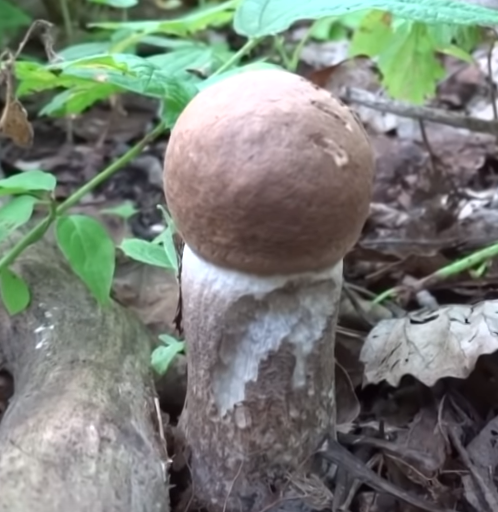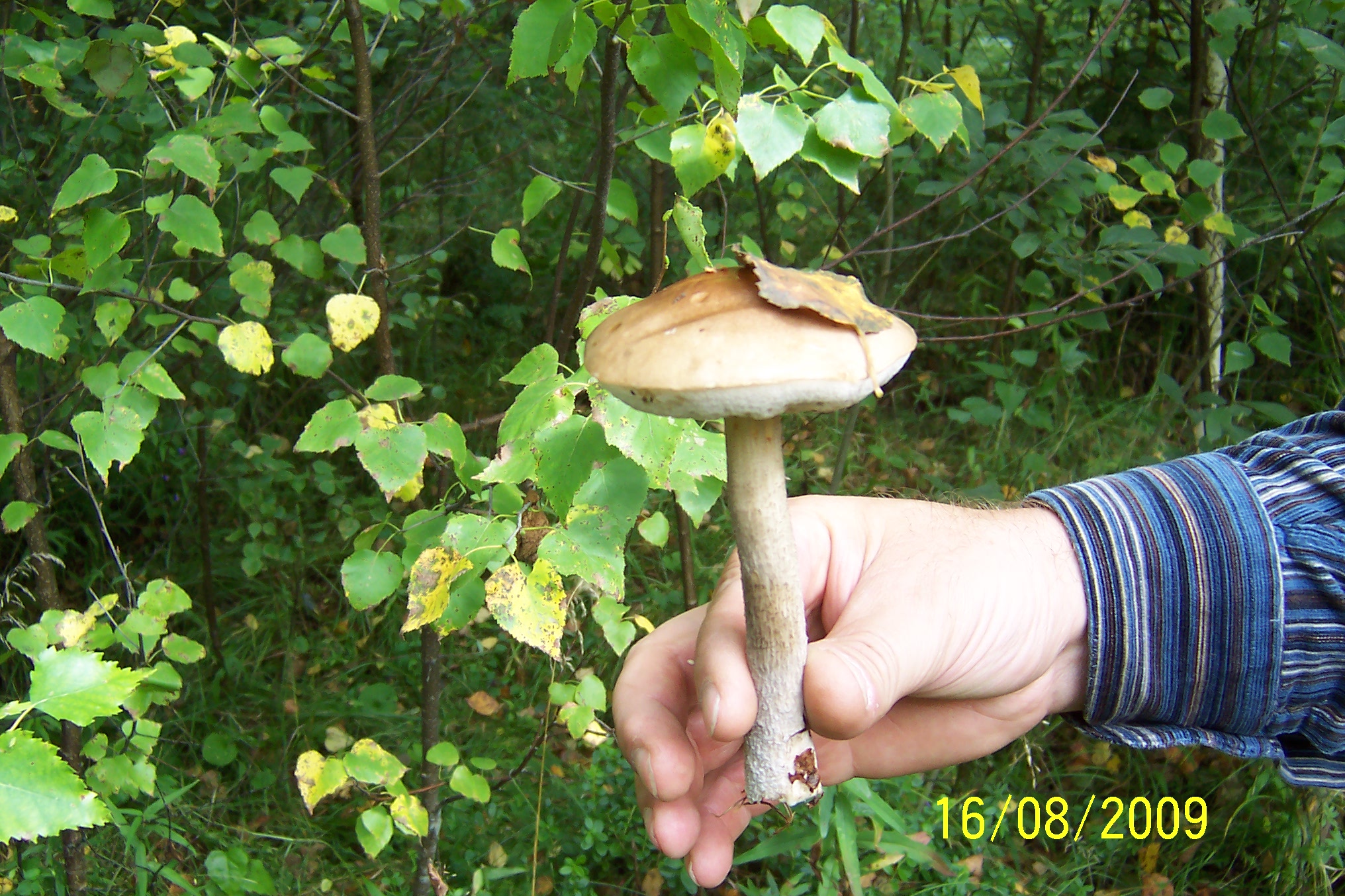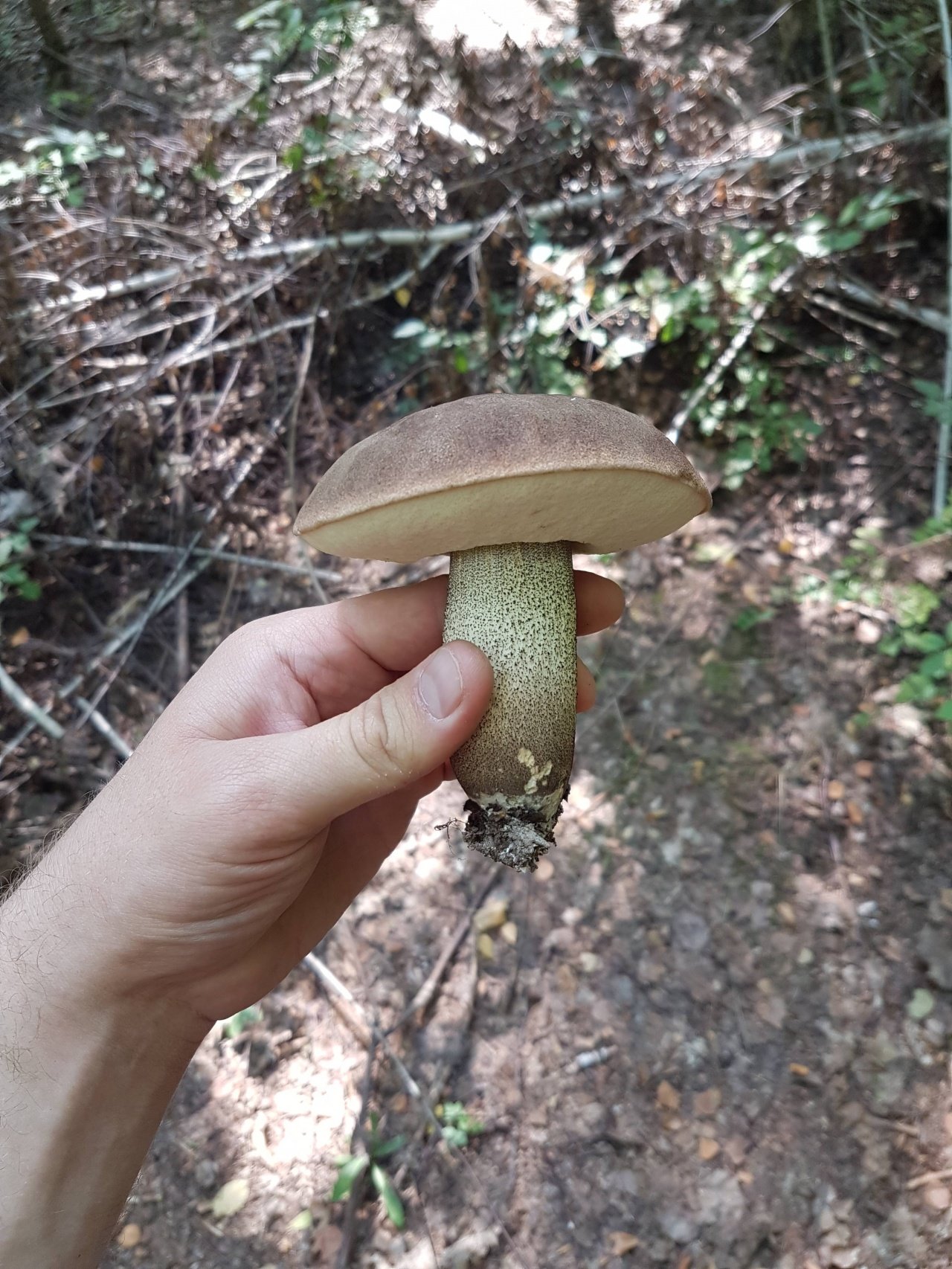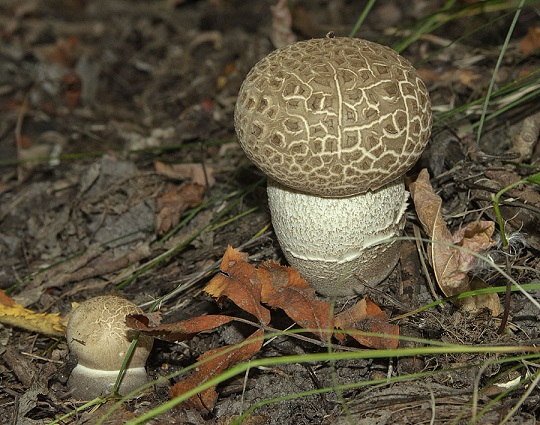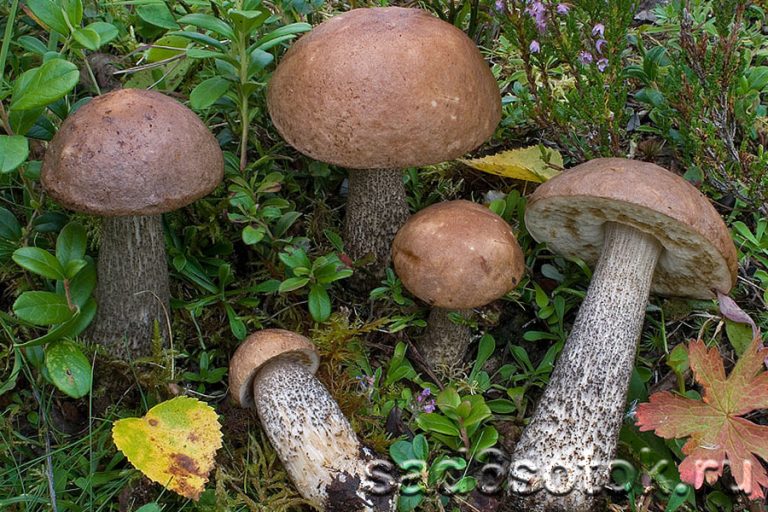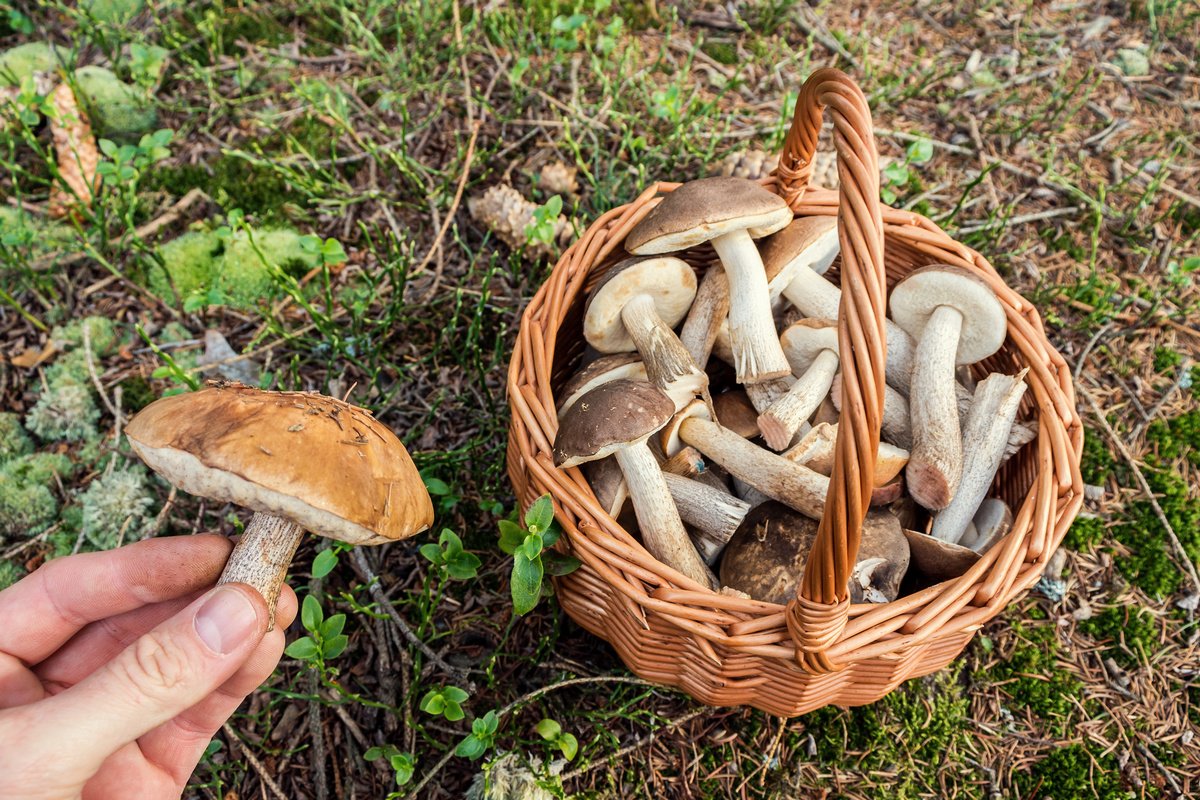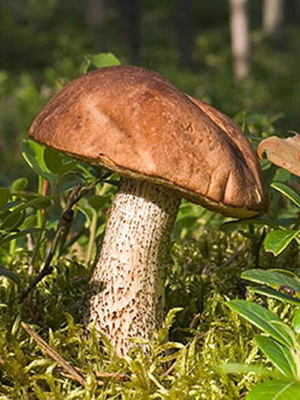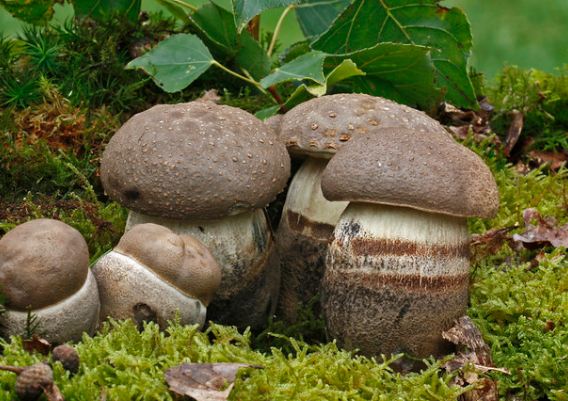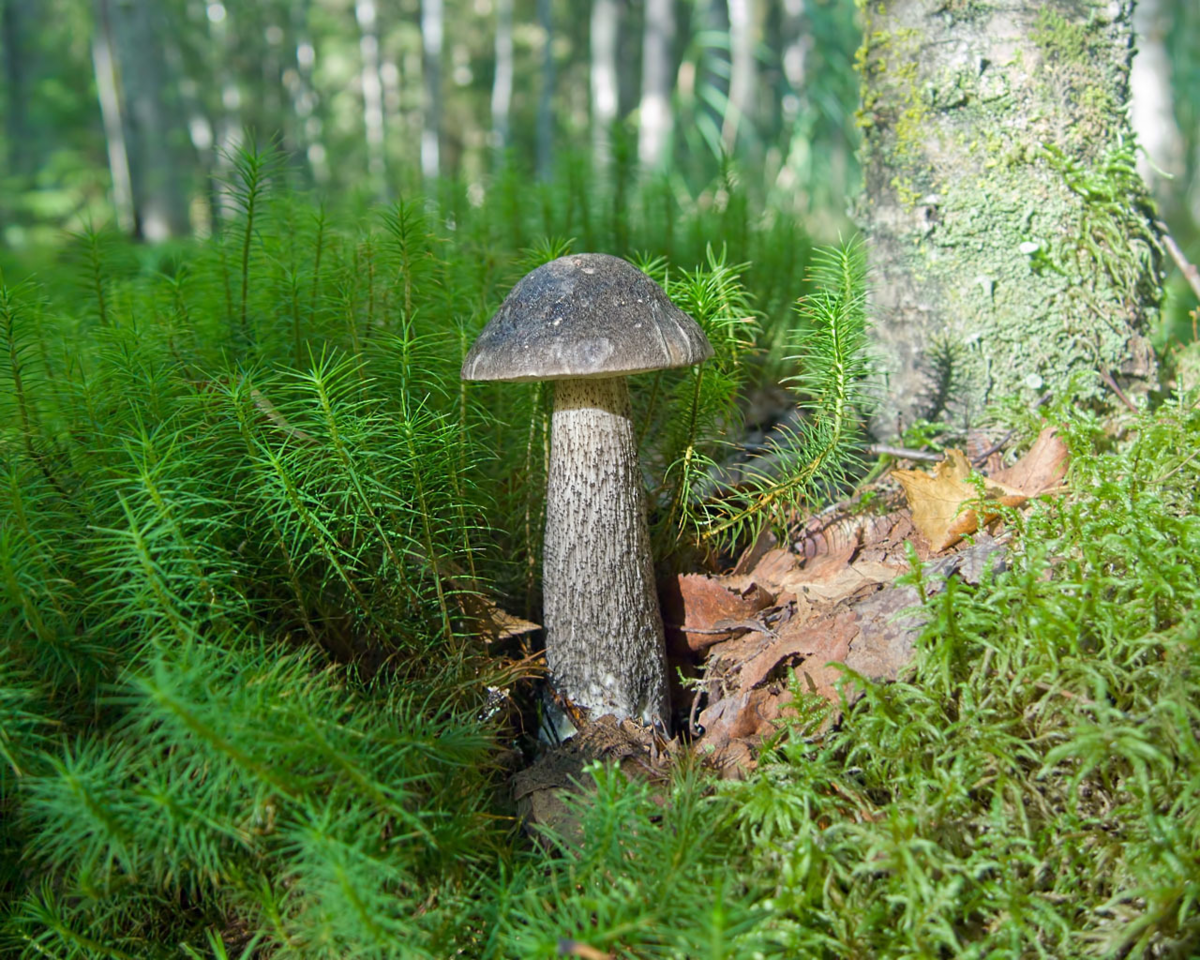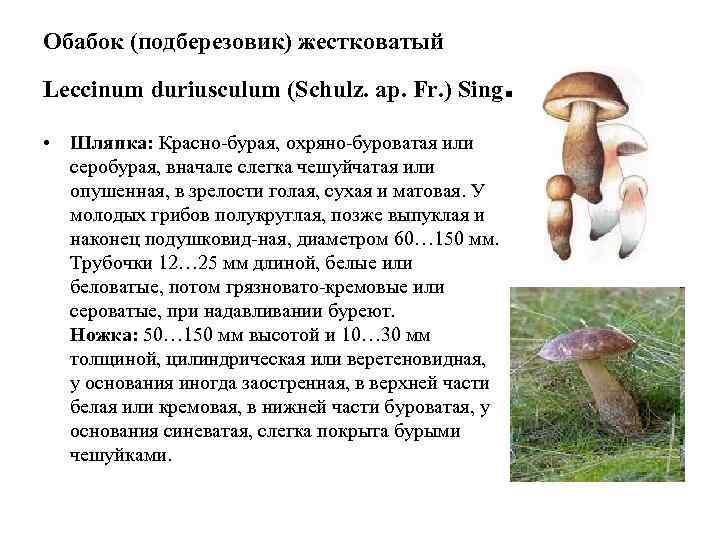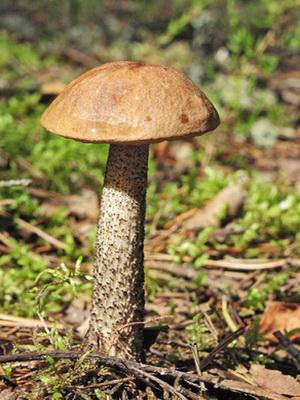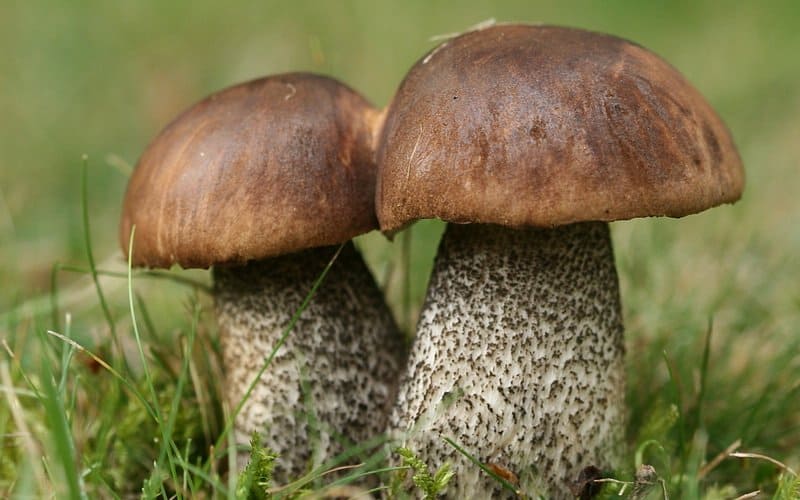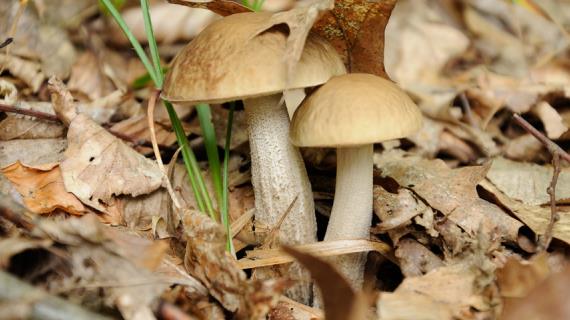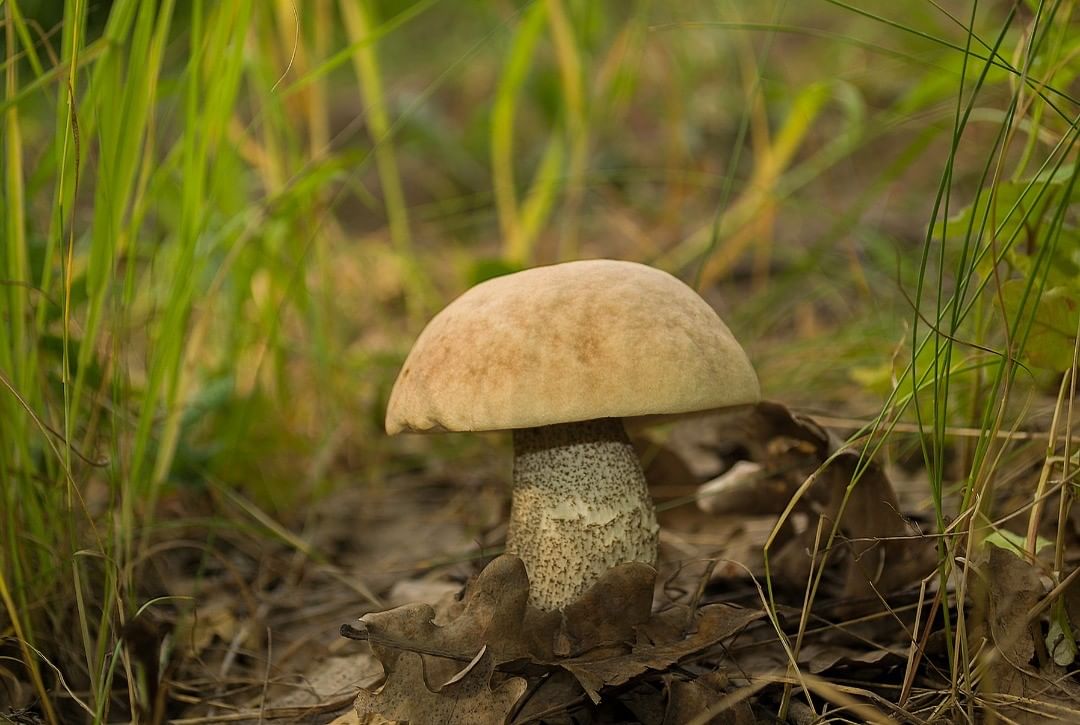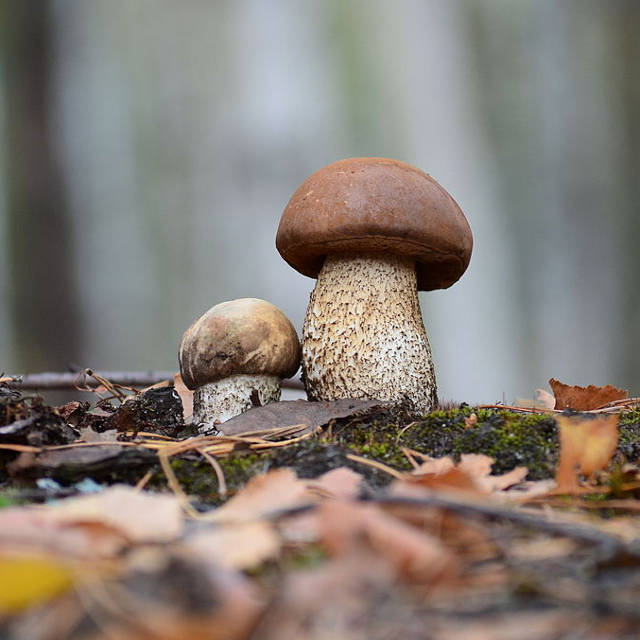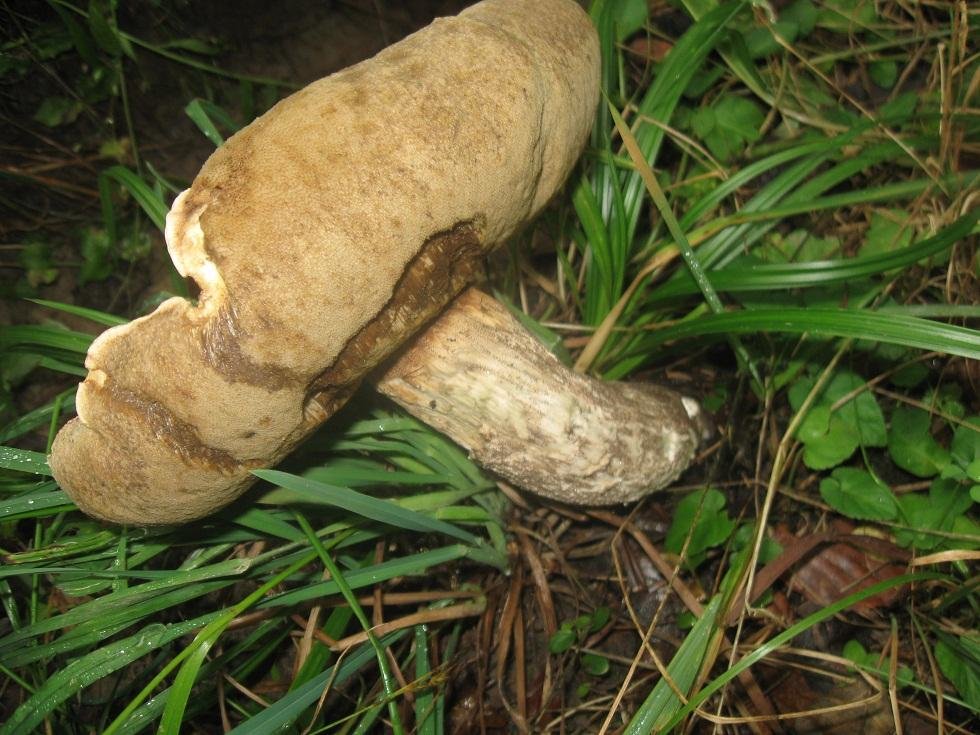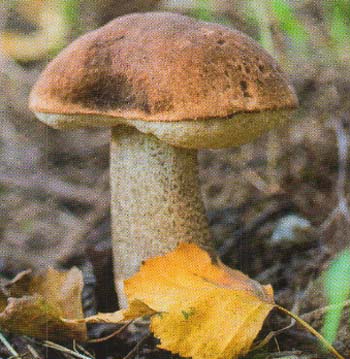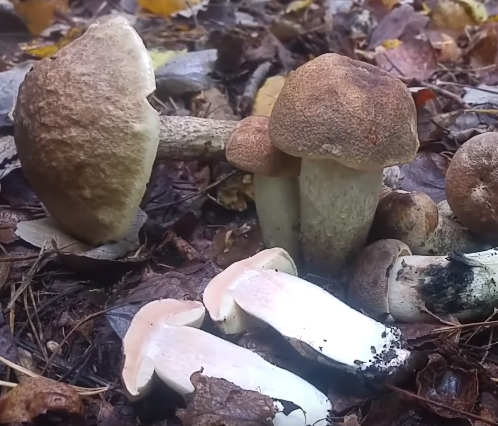False doubles
The types of boletus are quite similar to each other. You can also confuse mushrooms of this group with mushrooms - edible mushrooms.
However, when picking mushrooms, it is very important not to confuse them with poisonous species. The boletus has no ordinary poisonous twin, but there are several similar species that are not only not edible, but some are poisonous
Therefore, special care should be taken when collecting, especially for novice mushroom pickers. How to distinguish common boletus?
Gall mushroom

Most often, boletus is confused with a bile fungus (Tylopilus felleus). They cannot be poisoned, but it is also not suitable for food, since the taste of its pulp is very unpleasant, bitter, pungent, does not disappear during cooking, but only intensifies. There is no smell.
The cap of the gall fungus is hemispherical, the skin is glossy. Color: brownish, light chestnut. Diameter: up to 15 cm. Color of the tubes under the cap: hot pink, pink, dirty pink. The texture of the pulp is "greasy". White color. Spore powder mixed with dirty yellow spots.
Unlike common boletus, in which the cap is elastic, dense and does not change shape when pressed, in a gall fungus it is pressed in when pressed lightly and does not recover.
The leg of the gall fungus is slightly curved, thickened in the middle part. Covered with a special mesh pattern resembling a porcini mushroom, only of a dark color.
There are no insects on the surface of the mushroom, since they are not attracted by its bitter taste.
The gall fungus prefers wetlands. It can be found in coniferous and mixed forests, around tree stumps, near ditches and ravines.
Fruiting from mid-summer until frost.
Death cap

It is dangerous to confuse boletus with Amanita phalloides, which is a deadly poisonous mushroom.
The cap of the pale toadstool is hemispherical. In young mushrooms, it is shiny, light brown. As it grows, it becomes denser and takes on a light, greenish or olive shade. Diameter: up to 10 cm.
Under the cap are not tubules, as in common boletus, but wide snow-white plates.
Slender stem, no scales. As well as boletus it is lighter than the cap. Difference: the presence of a cuff under the cap, an extended base at the very ground, which is hidden in a kind of white pouch.
The pulp is fragile, does not darken on the cut. White color. Smell: weak, sweetish. Taste: sweet.
The pale toadstool can be found in deciduous and mixed forests. Grows under birches, aspens, beeches. Fruiting from July to October.
The distinguishing features of the pale toadstool from the common boletus include the absence of
- symbiosis with birch roots,
- characteristic mushroom aroma,
- insects on the surface.
How to collect
Red boletus appears in June and bears fruit until late October - early November. However, the mass season falls on the end of July - mid-September.
Although the mushroom can be found on the roots of a birch, in order to get rich trophies, it is better to get poisoned while collecting boletus boletus in a humid, swampy area.
The mushroom prefers shaded places, likes to hide among the moss. And if the weather is damp and humid, then individual blades of grass or a fallen leaf can stick to its sticky cap.
Therefore, when harvesting a multi-colored boletus, you need to show attention and patience.
When collecting, preference should be given to young specimens, because it is they who have the maximum taste and culinary qualities and are not much inferior to boletus. With age, unwanted changes in the pulp occur and old mushrooms are more susceptible to damage by insects and pests.
In addition, it should be noted that fungi tend to accumulate all kinds of toxins and heavy metals from the soil.And in order for the multicolored boletus to retain its useful properties for collection, you need to choose environmentally friendly places, far from industrial enterprises, both operating and abandoned, roads and railways, military facilities, etc.
All species of the genus Leccinum:
| Common boletus (Leccinum scabrum) | Black boletus (Leccinum melaneum) | Marsh boletus (Leccinum holopus) |
| Grabovik (Leccinum carpini) | Harsh boletus (Leccinum duriusculum) | Blackheads (Leccinum crocipodium) |
| Boletus multicolored (Latin Leccinum variicolor) | White-legged Boletus (Leccinum albostipitatum) | White Boletus (Leccinum percandidum) |
| Pine Redhead (Leccinum vulpinum) | Boletus yellow-brown (Leccinum versipelle) | Red Boletus (Leccinum aurantiacum) |
Common boletus (Leccinum scabrum) Black boletus (Leccinum melaneum) Marsh boletus (Leccinum holopus) Brown boletus (Leccinum carpini) Coarse boletus (Leccinum duriusculum) Black boletus (Leccinum duriusculum) Black birch boletus (Leccinum crociporium) White boletus (Leccinum crociporodium) white (Leccinum percandidum) Pine redhead (Leccinum vulpinum) Yellow-brown boletus (Leccinum versipelle) Red boletus (Leccinum aurantiacum)
UP
If you are in doubt about the edibility of the mushrooms you find, do not take them. The site administration does not bear any responsibility for the actions of people taken on the basis of the information received on the site. Some types of poisonous mushrooms cannot be identified without special equipment and can be confused with edible ones. For all questions related to the operation of the site, please contact the administration mailbox Copyright 2016 - 2020
Black boletus (blackened boletus): description and photo
| Name: | Blackening obbok |
| Latin name: | Leccinellum crocipodium |
| Type of: | Edible |
| Synonyms: | Leccinum nigrescens |
| Systematics: |
|
Boletus or blackening boletus (Leccinum nigrescens or Leccinellum crocipodium) is a mushroom of the Boletovye family. This is a typical representative of the genus Leccinellum with an average nutritional value.
Black boletus of medium-late fruiting
Where the blackening mushroom grows
Blackening obobok is a thermophilic species. The distribution area in Russia is the North Caucasus. It grows in any type of forest if it contains beech and oak, with the root system of which it forms mycorrhiza. Fruiting from late June to mid-September in dry, warm weather. The main accumulation of mushrooms is in moderately open, moist areas. There are solitary specimens or small compact groups. The species gives preference to acidic soils.
What does blackening look like
This is a medium-sized mushroom - up to 15 cm high with the same cap diameter. The color of the fruit body of young specimens is of a uniform bright yellow color, mature ones with a light brown tint.
Photo and external characteristics of the blackening trim:
- At the beginning of the growing season, the cap is in the form of a hemisphere, then gradually opens, becomes cushion-shaped with smooth blunt edges.
- The surface is even, often monochromatic, the protective layer is velvety with cracks of various shapes and sizes.
- The lower part of the cap is tubular, dense, the cells are small, the thickness of the spore-bearing layer is up to 3 cm, it has a clear notched border near the stem.
- The color is bright lemon at the beginning of growth, then it becomes darker.
- The leg is clavate, thickened near the ground. The structure is fibrous one-piece. The surface at the base is finely reticulated, closer to the cap it is scaly, pale yellow in color.
Radial stripes on the surface become wider towards the edge of the cap
The pulp is yellow in color, with a soft consistency, it can turn dark red or purple on the cut, then black. This feature gave the name to the species.
Is it possible to eat blackening curbs
The species is edible, in terms of nutritional value, it belongs to the third group. Fruit bodies do not require boiling or soaking before use. The taste and smell are weak.
Benefits and harm to the body
The fruit bodies have a high protein content, but with a low level of fats and carbohydrates. Overweight people include blackening in the diet. Fiber in the fruit bodies promotes the growth of bifidobacteria in the intestine, thereby improving the functioning of the gastrointestinal tract. Useful properties of fruit bodies:
- strengthen the immune system;
- stimulate the brain;
- calm the nervous system;
- help get rid of insomnia;
- restore liver cells;
- have antibiotic properties;
- destroy pathogenic microorganisms;
- promote tissue regeneration;
- participate in the process of hematopoiesis;
- lower cholesterol.
Mushroom dishes are contraindicated for use with exacerbation of chronic gastritis, women during lactation, small children.
False doubles
Outwardly, it looks like a blackening gall mushroom. It is distributed in the central and European part. The double is inedible due to its bitter taste, and is also poisonous. The color is light or dark brown with a pronounced coarse-mesh surface on the stem.
The pulp turns dark pink at the cut site
Use
Fruit bodies are universal in use: they are fried, boiled in soup, stewed or baked with vegetables and meat. Used for winter harvesting, pickled or salted. The obobok is dried, then the finished product will be dark in color. Good for freezing raw, boiled or fried.
Conclusion
Blackening gum is an edible mushroom, belongs to the third category. Fruiting bodies with a weak taste and indistinct odor. Fruiting of the species is abundant - from June to September. Common in warm climates. A distinctive feature of the stump is that the pulp at the cut site becomes pink.
Harsh boletus (Leccinum duriusculum)
- The birch is hardy;
- Poplar birch;
- Harsh obobok;
- The backbone is hard;
- Boletus duriusculus;
- Leccinum nigellum.
External description
The fruiting body of the hardish boletus consists of a stem and a cap. The flesh of the mushroom is white, very hard, but if you make a cut on the cap, it becomes reddish. If the base of the leg is damaged, the pulp becomes bluish, and after a while it acquires a gray-black tint. The aroma of the flesh of the harsh boletus is weak, there is a mushroom smell, it tastes pleasant.
The diameter of the cap varies within 6-15 cm. The shape of young mushrooms of the harsh boletus is convex and hemispherical, and in mature fruiting bodies it becomes cushion-shaped. On the skin of the fungus, there is initially a small edge, which, as it matures, completely disappears and the fungus remains naked. At high air humidity, the surface of the cap becomes mucous, with hanging edges. The color of the cap can be grayish-brown, gray-brown, ocher-brown, gray-brown.
The fungus hymenophore is tubular. The tubules are 10 to 25 mm long, initially white, gradually turning creamy yellow, and when pressed, change color to grayish brown or olive brown. The constituent components of the hymenophore are spores characterized by an ellipsoid-fusiform or ellipsoidal shape. The color of the spore powder varies from ocher-brownish to light ocher. The spore sizes are 14.5-16 - 4.5-6 microns.
The length of the mushroom leg varies between 40-160 mm, and its diameter is 10-35 mm. In shape, it is spindle-shaped or cylindrical, sometimes it can be pointed at the base. The upper part of the mushroom leg is characterized by a whitish color, and bluish spots are often noticeable at the base. Below, the color of the leg is brownish, and its entire surface is covered with brown scales.

Season and habitat of the mushroom
The harsh boletus grows in mixed and deciduous forests, right on soils. It has the ability to form mycorrhiza with poplars and aspens. You can meet this mushroom both in groups and in single growth. The harsh boletus prefers to grow on calcareous soils.Rarely, but still you can find this type of boletus on loam and sandy soils. Fruiting of the mushroom occurs from mid-July to the end of October (sometimes the fruiting bodies of the hardish boletus can be found in mid-November). In the past few years, more and more information has appeared that the harsh mushroom is spreading more widely, it is found more and more often and in large quantities.
Edibility
Harsh boletus is an edible mushroom, in which, in comparison with other types of boletus, the flesh is much denser. Worms are very rarely found in it, and it is recommended to use the harsh boletus in dried or fresh form. It is used to prepare various delicious dishes.
Similar types and differences from them
The described species is similar to many other species of boletus. However, the harsh boletus has no similarities with poisonous or inedible mushrooms.
Mushroom photo Boletus harsh from questions in recognition:
| Group: | Tubular |
|---|---|
| Plates: | White, grayish |
| Colour: | Shades of brown, from grayish to ocher |
| Info: | The pulp turns pink at the cut |
| Department: | Basidiomycota (Basidiomycetes) |
|---|---|
| Subdivision: | Agaricomycotina (Agaricomycetes) |
| Class: | Agaricomycetes (Agaricomycetes |
| Subclass: | Agaricomycetidae |
| Order: | Boletales |
| Family: | Boletaceae |
| Genus: | Leccinum (Obabok) |
| View: | Leccinum duriusculum (Harsh boletus) |
This type of boletus for mushroom hunting lovers is perhaps the most desirable among all its numerous relatives. The harsh boletus is devoid of almost all the disadvantages inherent in boletus. It is practically not affected by insect larvae, its pulp is dense and does not contain excess moisture, extremely aromatic.
How can you tell them apart?
The most common in Russia is the common boletus (Leccinum scabrum). A pretty mushroom with gray-brown to reddish-brown caps, a long white stem covered with gray or brownish scales. In young fungi, the legs are often barrel-shaped, then lengthen and "lose weight". The flesh of the cap is white, it may turn slightly pink at the break. It grows throughout Russia, where there are trees, from June to autumn.
Grabovik, or Gray Boletus (Leccinum griseum) may have grayish or brown shades in the color of the cap and some wrinkling (but may not have). With age, the cap becomes fissured. On cut, it changes color to pinkish-gray-violet to dark gray. It grows in places where hornbeam, oak, hazel, elm, poplar grow from June to October.
Marsh boletus (Leccinum holopus) is distinguished by a pale color (from whitish to light brown) and an almost white or slightly grayish leg. The pulp is white, does not change color at the break. Grows in dampness, near swamps, bears fruit from July to September.
Blackhead, or black brown boletus (Leccinum melaneum) has a relatively small, dense, dark brown cap. On the cut, the pulp either does not change color, or turns brown a little. Often grows in pine forests, as well as in damp places from the middle of summer. It is less often wormy than other types of boletus.
There is also a species that is not very susceptible to worminess - the harsh boletus (Leccinum duriusculum). It seems to me that it looks more like a boletus in terms of density and the shape of a hat. Only the color is different, brownish shades. Sometimes it looks like a boletus, only the leg gives out, it is scaly. In the section, it shows signs of different stumps: the flesh of the cap turns slightly pink, the upper part of the leg becomes gray-reddish, below it turns blue with further blackening. Grows in deciduous and mixed forests throughout Russia from mid-summer to late autumn.
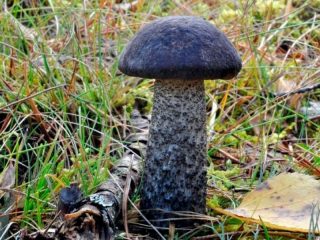 Blackhead, or black boletus (Leccinum melaneum). blabto
Blackhead, or black boletus (Leccinum melaneum). blabto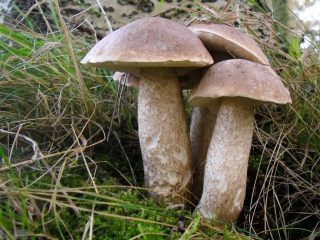 Harsh boletus (Leccinum duriusculum). gdnovisad
Harsh boletus (Leccinum duriusculum). gdnovisad
Is there some more:
- multicolored boletus (Leccinum variicolor) with a gray-white hatched cap;
- brown birch (Leccinum roseofractum) with the flesh of the cap turning pink, and then darkening at the fracture (by the way, the color of the cap is also shaded, only in brownish tones);
- Chess birch (Leccinum nigrescens) with a light yellow flesh of the cap, turning red or brown at the break, followed by blackening. His hat is brownish, often cracking.
There are also much rarer species of boletus with very similar characteristics. It's not scary to confuse the types of boletus birch - they are all quite edible and tasty. The main thing is to know the differences from inedible and poisonous ones.
Red boletus (Leccinum variicolor). Jörg Hempel Leccinum roseofractum. Frank Gardiner- Expect Chess Boletus (Leccinum nigrescens). Adrian.benko
How to store a grabber
An important point in the preparation of a hornbeam is the container. Plastic bags are not suitable for these purposes, as mushrooms in them die and quickly deteriorate. The best option is a traditional basket: it allows air to pass through and allows the mushrooms to lie freely without squeezing each other.
Also, in search of mushrooms under the leaves, a long stick with a spear at the end is a good helper. It also protects against contact with poisonous plants.
Grabovik is a plant that, due to the loose texture of the cap, cannot be stored for a long time and should be processed as quickly as possible. Experts recommend doing this within 12 hours of collection.
After returning home, the mushrooms are carefully sorted out. First of all, the collected grabos are checked for the presence of worms, for which they are cut and carefully examined. If infected parts are found, they are cut out. Completely affected specimens are discarded.
Also, mushrooms should be removed, in which individual parts have a darker color, which may be a sign of decay.
Gray boletus (hornbeam) has high taste properties and is suitable for all types of workpieces. It can be frozen, dried, salted, pickled.
Preliminary preparation
With any kind of workpiece, with the exception of drying, the first step in using the grabber is pre-processing.
Mushrooms are wiped with a sponge to remove dirt, moss, etc.
Particular attention is paid to the base of the leg.
If the hornbeam is assembled on sandy ground, then the leg should be scraped off using a knife.
In older specimens, the tubular layer is removed. It can only be left if the mushrooms are to be pickled or salted.
In a sufficiently large container, boletus mushrooms are poured with plenty of water and washed thoroughly by hand.
The procedure is repeated several times. Then the mushrooms are poured with water and left to soak, during which various debris and impurities lag behind them, which are easy to remove.
The washed mushrooms are thrown into a colander and allowed to drain.
The next mandatory stage of preliminary preparation is boiling. How to cook a grabber? Boiling is carried out in two stages: at the beginning, to remove debris and pests, the mushrooms are poured with water, brought to a boil, the liquid is drained. Then cook in clean salted water until tender - about 20 minutes.
Boiled mushrooms are stored in the refrigerator for no longer than two days. They can also be placed in plastic bags with sealed valves and frozen. In the latter case, the shelf life is significantly increased.
How to cook
The grabovik resembles an ordinary boletus in its taste and culinary recipes for it can be safely borrowed from its relative. There are a lot of ways to prepare a hornbeam and they are very diverse. The mushroom is delicious in almost any form and is used for making sauces, soups, roasts, as a filling for pies, fried, stewed. Suitable as an ingredient for other dishes.
You should also pay attention to the fact that in its raw form, the hornbeam brings harm to health, only after heat treatment the taste and aroma of the mushroom are fully revealed.
How to cook

The pink boletus has a dense, fleshy pulp, a rich, rich mushroom aroma and a sweetish, delicate taste. It showed itself well in boiled, fried, stewed, baked form. It can even be eaten raw. Therefore, there are a lot of recipes for making pink boletus. Often serves as a filling for pies, pizza, rolls, etc.
However, it should be borne in mind that the structure of the pulp of the cap and leg is different. Legs, being more rigid, require a longer heat treatment, so they are more suitable for making soups, sauces, main courses. They go well with vegetables, meat.
The disadvantage of pink boletus is that after heat treatment it turns black. This is not a sign of spoilage and does not affect the quality of the finished dish. Taste and aroma properties remain unchanged.
The use of boletus ordinary folk medicine
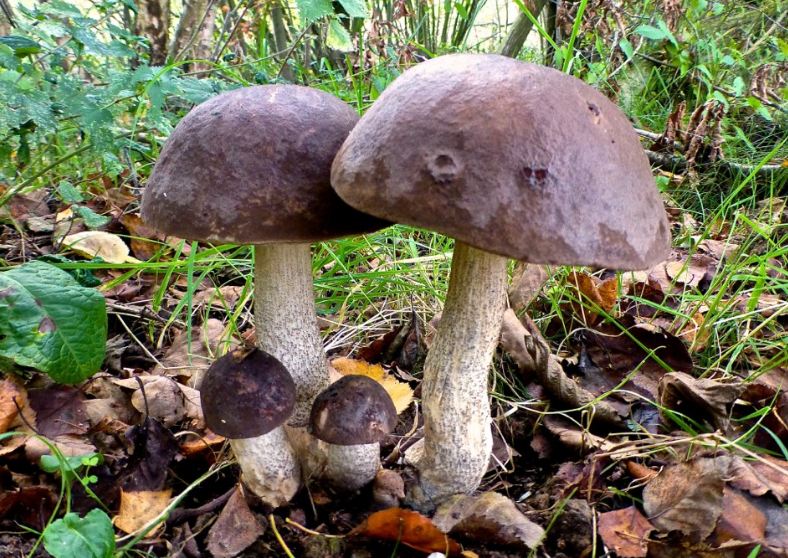
Due to its properties, common boletus has found application in folk medicine. For these purposes, mainly dry mushroom powder and red wine tincture are used.
What you should pay attention to
Common boletus is a valuable food product that is often present on the table of mushroom lovers and connoisseurs, as a component of many dishes. However, during treatment, its use should be carried out on an ongoing basis and in a certain amount.
To get a positive effect, you should take into account the beneficial properties of boletus boletus and the contraindications that it possesses when applying. Also, many people, especially the elderly, have several chronic diseases.
Only a doctor, and better a phytotherapist, can take all these points into account and prescribe the correct treatment. The information given below is for informational purposes only.
For the heart and blood vessels
The beneficial properties of boletus boletus have shown a good effect, mainly for the prevention of cardiovascular diseases. The course administration of mushroom preparations cleanses blood vessels, including from cholesterol deposits, stimulates blood circulation, and strengthens the heart muscle.
For the gastrointestinal tract
Common boletus belongs to mushrooms that are relatively easy to digest and assimilate in the gastrointestinal tract and do not require additional expenditure of digestive juices. Regular consumption of the mushroom helps to improve digestion.
Kidney disease
They recommend treatment with boletus boletus, both acute and chronic kidney diseases. As a prophylactic agent, mushroom preparations normalize the functioning of organs, improve their functionality, and maintain a healthy state.
For men
A good result is the use of the medicinal properties of boletus boletus, as a means to improve potency and improve the reproductive system of men.
Oncological diseases
Boletus boletus is of value in complex therapy for the treatment of cancer. Plant preparations inhibit the growth of cancer cells, promote the restoration of lost telomeres (information links) of DNA molecules, increase the synthesis of NK cells and macrophages responsible for antitumor immunity. Thus, common boletus is also applicable for the prevention of cancer.
For nerves
Common boletus preparations normalize the activity of the nervous system and are used for some diseases of this direction.
Skin diseases, wounds, ulcers
The useful and medicinal properties of boletus boletus and its use have shown themselves well for the treatment of skin diseases, as well as wounds and ulcers. They have a positive effect on the condition of the skin and mucous membranes.
For these purposes, an ointment made from dried mushroom powder diluted with a small amount of boiling water is used as an anti-inflammatory and wound healing agent. For washing and lotions, use a decoction / infusion of boletus boletus.
Diseases of the joints
As an aid in the treatment of joints, boletus boletus is recommended. The plant contains a significant amount of phosphorus and calcium, which has a positive effect on the condition of teeth, bones, musculoskeletal system, bone marrow.
The preparations of boletus are also applicable for prophylaxis.
For metabolism
The medicinal properties of boletus boletus have found application, both for treatment and for the prevention of metabolic disorders. A course intake of plant preparations normalizes the hypothalamic-pituitary and adrenal systems, stimulates the activity of the thyroid gland, and regulates blood sugar levels.
For beauty
Boletus boletus is a folk remedy for skin, hair and nails care. Regular face masks made from the crushed pulp of the plant make the skin elastic, smoothen it, have a tonic effect, and protect against premature aging and the destructive effect of free radicals. For a more lasting result, a course internal intake of boletus boletus preparations is carried out in parallel.
Also, a decoction / infusion of boletus is used for rinsing hair after hygienic washing. And the baths help to strengthen the nails.
Spreading
The boletus mushroom is widespread. It can be found in Europe, Asia and America; this representative of the third kingdom successfully mastered even the climate of the tundra. Prefers light mixed or deciduous forests with the obligatory presence of birches. Forms mycorrhiza with birches, and chooses young trees. It grows especially well in mixed coniferous forests with young birch forests.
Fruiting begins in July and lasts until late autumn. If the summer is not too dry, single specimens can be found already at the end of June. A characteristic feature of boletus boletus is a massive, industrial return.
Fruit bodies sprout amicably, filling large areas; the intensity of germination after the first harvest does not drop. At the same time, the mushroom can completely disappear for a long time and for no apparent reason, and after a "break" it can return with the same industrial volume.
Description
The cap is 6-15 cm in diameter, in young mushrooms it is hemispherical, later convex, in mature mushrooms it is cushion-shaped, sometimes with a slightly depressed center. The skin of the cap is slightly pubescent or appressed-scaly; in maturity it is glabrous, smooth and dull, in wet weather it is mucous; hangs over the tubules. The color of the cap is extremely variable - from pale gray-brown with a slight violet tint to ocher, umber or reddish brown; in young mushrooms it is the same color as the pulp, later it is much darker.
The flesh is firm, white in the cap and upper part of the stem, often yellowish-green at the base of the stem; at the break in the cap turns pink or reddens, at the top of the leg becomes reddish-gray, at the base of the leg turns green or blue, later turns black. The taste is pleasant; the smell is weak, mushroom.
12-25 mm long, from adherent to almost free, whitish, then creamy yellowish or grayish, when pressed become olive brown. The pores are small, 0.3-0.5 mm in diameter, round, whitish, then creamy yellowish.
Stem 5-16 x 1-3.5 cm thick, cylindrical or fusiform, sometimes pointed at the base, solid, whitish or creamy in the upper part, brownish in the lower part, bluish at the base; covered with brown or blackish scales, increasing towards the base, often in longitudinal rows or ridges and sometimes, especially in the upper part of the stem, merging into a net pattern, in sharp contrast to the whitish surface of the stem.
Microstructures
The spore powder is olive-brown or light ocher. Spores 13-17 x 5-7 microns, ellipsoid or ellipsoid-fusiform, smooth, relatively thick-walled, pale ocher.
Basidia 19–37 x 6.0–9.0 µm, clavate, tetrasporous. Gymnial cystids 20-75 x 5.5-17 x 2.0-4.0 µm, bottle-shaped, colorless or with brown intracellular pigment. Caulocystids 25-110 x 5.0-12 x 2.0-6.5 microns, bottle-shaped or fusiform, thin or thick-walled, colorless or with brown intracellular pigment. There are no buckles.

